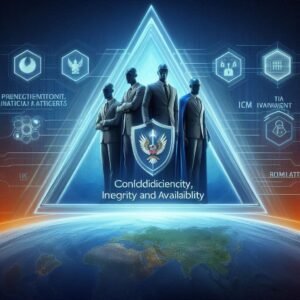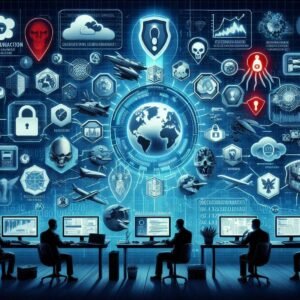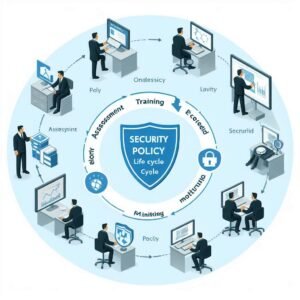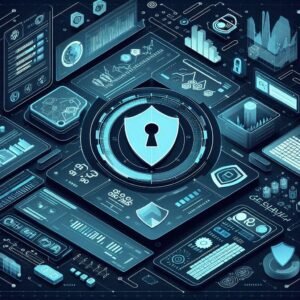Guardians of the Digital Age:
The Human-Centric Guide to Information Security in 2025
Introduction: The Reality of Information Security

In 2025, the world is more connected and more vulnerable than ever before. As data breaches and cyberattacks grow in frequency and sophistication, information security has become a non-negotiable priority for individuals and organizations alike. This blog unpacks the latest best practices, real world threats, essential frameworks and future trends offering actionable advice for securing what matters most.
What Is Information Security? (And Why You Should Care)
Information security means protecting data from unauthorized access, use, disclosure, disruption, modification, or destruction. This isn’t something reserved for IT departments cybersecurity is everyone’s responsibility.
Three Pillars: Confidentiality, Integrity, Availability
-
Confidentiality: Ensuring only the right people access sensitive information.
-
Integrity: Safeguarding info from being tampered with, either by accident or malice.
-
Availability: Making sure systems and data are accessible whenever they’re needed.

The Evolving Threat Landscape: Why Cybersecurity Matters More Than Ever
Modern attackers aren’t just faceless hackers they are organized groups, automated bots, or even insiders. Common threats include:
-
Phishing and Social Engineering: Deceptive messages designed to trick users into revealing sensitive information.
-
Ransomware: Malicious software that locks data until the victim pays a ransom.
-
Data Breaches: Unauthorized exposure of confidential data, either from external attacks or internal mistakes.
-
Insider Threats: Employees or contractors who misuse their access.
-
Supply Chain Attacks: Infiltration through third-party vendors or service providers.

Building a Robust Information Security Policy
A strong security policy forms the backbone of organizational defense. Every company, no matter its size, should follow a thoughtful process.
Key Steps:
-
-
Risk Assessment: Identify what data needs protecting and how it could be at risk.
-
Define Policies & Procedures: Set clear, practical rules for handling information, responding to incidents, and granting access.
-
Assign Roles & Responsibilities: Ensure everyone knows their part security isn’t just IT’s job.

How a security policy evolves with your organization. -
Implement Controls: Use technology (like firewalls and encryption) and procedures (like regular audits) to minimize risk.
-
-
Ongoing Training: Equip staff with the knowledge to recognize and report threats.
-
Continuous Monitoring: Track systems for anomalies, launch rapid response to incidents, and review policies regularly.
Human Factor: The Strongest (and Weakest) Link
The best technical measures can fail if people ignore basic safety practices. Human error or risky behaviors are behind many breaches. Empowering people with training and a proactive security culture is crucial.
Security habits to encourage:
-
Use strong, unique passwords and enable multi-factor authentication.
-
Think twice before clicking links or opening attachments.
-
Report suspicious activity, even if it seems minor.
-
Keep software and devices up to date with the latest patches.
-
Use secure Wi-Fi, especially when handling sensitive data remotely.

Regulatory Environment: Compliance and Beyond
Globally, new laws are holding businesses more accountable than ever before. Frameworks like the Data Protection and Privacy (DPDP) Act, SOC 2, or ISO 27001 require robust security controls and regular audits.
-
Why it matters: Failing to comply can mean hefty fines, loss of trust, or even legal action.
-
Tip: Don’t treat compliance as a checkbox. Use it as a roadmap to a safer organization.
The Technology Toolkit: Essential Security Tools and Practices
Effective information security blends people, process, and technology. Some technical essentials:
-
Firewalls and Intrusion Detection Systems (IDS): Monitor and filter out malicious traffic.
-
Encryption: Protects data both at rest and in transit essential for sensitive information.
-
Endpoint Protection: Secures devices from malware and unauthorized access.
-
Backup Solutions: Enables quick recovery from ransomware or hardware failures.
-
Access Management: Ensures the right people have the right level of access.

Trends Shaping the Future of Information Security
Looking ahead, several forces are reshaping the cybersecurity landscape:
-
AI and Automation: Both a risk and a defense; attackers use AI-driven malware while defenders rely on automated monitoring.
-
Zero Trust Security: Never trust, always verify, regardless of origin applies strict access controls everywhere.
-
Remote Work Security: More organizations are securing endpoints and data as people work from anywhere.
-
Cloud Security: As data moves to the cloud, security relies on shared responsibility between providers and customers.
-
Privacy-First Design: Regulations and consumer expectations are driving ‘privacy by default’ architectures.

Creating a Security-First Culture: Actionable Tips
-
Schedule regular security awareness sessions tailored to different roles.
-
Celebrate “caught” phishing attempts as wins for the team.
-
Conduct periodic drills (like mock-phishing emails or response simulations).
-
Set clear reporting channels for suspected incidents.
-
Encourage leaders to model best practices by participating visibly in training.
Conclusion: Everyone’s Role in Securing the Digital Future
No single tool, policy, or person can guarantee complete protection. But by building awareness, embracing proven frameworks, adhering to best practices, and fostering a proactive security culture, organizations and individuals alike are better equipped to guard the digital front lines. The future belongs to those who take information security seriously today.
Pingback: डिजिटल युग के रक्षक